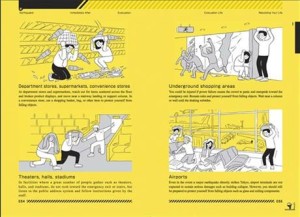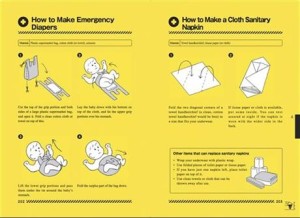In case of an emergency, want to know how to make a diaper out of a plastic supermarket bag and a towel? How to make a size D battery out of an AA? How to keep warm with newspaper?
[caption id="attachment_19797" align="alignright" width="300"]

The Great East Japan Earthquake in Iwate[/caption]
In Tokyo, city planners have been studying the
2011 earthquake and tsunami that hit less than 200 miles to the northeast. The disaster left more than 18,000 people dead or missing, damaged a million buildings,
displaced a quarter of a million people and left 4.4 million people without electricity and 1.5 million without water. A nuclear reactor damaged during the disaster
is still releasing radioactive material into the ocean, and a month ago, scientists found traces of cesium from the reactor accident
about 1,600 miles off the U.S. West Coast.
In response, Tokyo planners prepared a 300-page disaster guidebook and in December mailed it to every residence. Guides were also distributed to local bookstores, where they sold out at $1.15 each. They’re planning another printing. The book was translated into English, Chinese and Korean and is available to
download free online here.
[caption id="attachment_19803" align="alignright" width="300"]

Tokyo Metropolitan Government Office via AP[/caption]
The book is incredibly detailed –
one of its suggestions is “exchange greetings with neighbors regularly.” Its main focus is how to deal with an earthquake and its aftermath while in an urban area. For example, in its first chapter the book points out that fire caused 10 percent of deaths
in a 1995 earthquake. So if a fire is tiny, it recommends trying to put it out, but if it seems unsafe, like if flames are touching the ceiling, leave.
It tells
how to prepare before an earthquake, like how to stabilize furniture by putting anti-slip pads underneath and what to put in an emergency kit.
In another chapter it talks about
other types of disasters, like – no kidding – missile attack, tornado, volcanic eruption and pandemic.
It had this advice for dealing with a nuclear incident:
“If there is a nuclear explosion, hide behind cover and evacuate to an underground facility or strong building. An explosive called a “dirty bomb” will cause radioactive contamination of the area. Follow the instructions of the authorities and consult a physician.”
[caption id="attachment_19798" align="alignright" width="300"]

Tokyo Metropolitan Government Office via AP[/caption]
Finally, it gives all kinds of
substitutions for everyday products. To make a diaper, cut open the top and sides of a plastic grocery bag and lay it flat. Put a towel in the middle. Then tie the top and bottom parts around the baby.
To make a size D battery out of an AA, wrap cloth around the battery until it is the width of a D, then use crumpled aluminum foil to adjust the length.
To keep warm with newspaper, wrap several layers around like a cloak. Or fold two sheets of newspaper around your abdomen and wrap plastic wrap around them.
Here’s a bonus idea: to make an emergency toilet, put two plastic bags inside a bucket or cardboard box then put torn paper in the bottom of the bag. After using the toilet, remove the top plastic bag and take it to a designated waste area.
The book is easy to follow and mostly illustrations. It includes advice from people who lived through earthquakes and summaries and activities at the end of each chapter. After reading it, I’ve decided to add a bunch of grocery bags to my emergency kit – those suckers are incredibly useful. Also, I’m so thankful for where I live (Missile attacks? Hello.).
What emergencies are you prepared for?

 The Great East Japan Earthquake in Iwate[/caption]
In Tokyo, city planners have been studying the 2011 earthquake and tsunami that hit less than 200 miles to the northeast. The disaster left more than 18,000 people dead or missing, damaged a million buildings, displaced a quarter of a million people and left 4.4 million people without electricity and 1.5 million without water. A nuclear reactor damaged during the disaster is still releasing radioactive material into the ocean, and a month ago, scientists found traces of cesium from the reactor accident about 1,600 miles off the U.S. West Coast.
In response, Tokyo planners prepared a 300-page disaster guidebook and in December mailed it to every residence. Guides were also distributed to local bookstores, where they sold out at $1.15 each. They’re planning another printing. The book was translated into English, Chinese and Korean and is available to download free online here.
[caption id="attachment_19803" align="alignright" width="300"]
The Great East Japan Earthquake in Iwate[/caption]
In Tokyo, city planners have been studying the 2011 earthquake and tsunami that hit less than 200 miles to the northeast. The disaster left more than 18,000 people dead or missing, damaged a million buildings, displaced a quarter of a million people and left 4.4 million people without electricity and 1.5 million without water. A nuclear reactor damaged during the disaster is still releasing radioactive material into the ocean, and a month ago, scientists found traces of cesium from the reactor accident about 1,600 miles off the U.S. West Coast.
In response, Tokyo planners prepared a 300-page disaster guidebook and in December mailed it to every residence. Guides were also distributed to local bookstores, where they sold out at $1.15 each. They’re planning another printing. The book was translated into English, Chinese and Korean and is available to download free online here.
[caption id="attachment_19803" align="alignright" width="300"] Tokyo Metropolitan Government Office via AP[/caption]
The book is incredibly detailed – one of its suggestions is “exchange greetings with neighbors regularly.” Its main focus is how to deal with an earthquake and its aftermath while in an urban area. For example, in its first chapter the book points out that fire caused 10 percent of deaths in a 1995 earthquake. So if a fire is tiny, it recommends trying to put it out, but if it seems unsafe, like if flames are touching the ceiling, leave.
It tells how to prepare before an earthquake, like how to stabilize furniture by putting anti-slip pads underneath and what to put in an emergency kit.
In another chapter it talks about other types of disasters, like – no kidding – missile attack, tornado, volcanic eruption and pandemic.
It had this advice for dealing with a nuclear incident:
“If there is a nuclear explosion, hide behind cover and evacuate to an underground facility or strong building. An explosive called a “dirty bomb” will cause radioactive contamination of the area. Follow the instructions of the authorities and consult a physician.”
[caption id="attachment_19798" align="alignright" width="300"]
Tokyo Metropolitan Government Office via AP[/caption]
The book is incredibly detailed – one of its suggestions is “exchange greetings with neighbors regularly.” Its main focus is how to deal with an earthquake and its aftermath while in an urban area. For example, in its first chapter the book points out that fire caused 10 percent of deaths in a 1995 earthquake. So if a fire is tiny, it recommends trying to put it out, but if it seems unsafe, like if flames are touching the ceiling, leave.
It tells how to prepare before an earthquake, like how to stabilize furniture by putting anti-slip pads underneath and what to put in an emergency kit.
In another chapter it talks about other types of disasters, like – no kidding – missile attack, tornado, volcanic eruption and pandemic.
It had this advice for dealing with a nuclear incident:
“If there is a nuclear explosion, hide behind cover and evacuate to an underground facility or strong building. An explosive called a “dirty bomb” will cause radioactive contamination of the area. Follow the instructions of the authorities and consult a physician.”
[caption id="attachment_19798" align="alignright" width="300"] Tokyo Metropolitan Government Office via AP[/caption]
Finally, it gives all kinds of substitutions for everyday products. To make a diaper, cut open the top and sides of a plastic grocery bag and lay it flat. Put a towel in the middle. Then tie the top and bottom parts around the baby.
To make a size D battery out of an AA, wrap cloth around the battery until it is the width of a D, then use crumpled aluminum foil to adjust the length.
To keep warm with newspaper, wrap several layers around like a cloak. Or fold two sheets of newspaper around your abdomen and wrap plastic wrap around them.
Here’s a bonus idea: to make an emergency toilet, put two plastic bags inside a bucket or cardboard box then put torn paper in the bottom of the bag. After using the toilet, remove the top plastic bag and take it to a designated waste area.
The book is easy to follow and mostly illustrations. It includes advice from people who lived through earthquakes and summaries and activities at the end of each chapter. After reading it, I’ve decided to add a bunch of grocery bags to my emergency kit – those suckers are incredibly useful. Also, I’m so thankful for where I live (Missile attacks? Hello.).
What emergencies are you prepared for?
Tokyo Metropolitan Government Office via AP[/caption]
Finally, it gives all kinds of substitutions for everyday products. To make a diaper, cut open the top and sides of a plastic grocery bag and lay it flat. Put a towel in the middle. Then tie the top and bottom parts around the baby.
To make a size D battery out of an AA, wrap cloth around the battery until it is the width of a D, then use crumpled aluminum foil to adjust the length.
To keep warm with newspaper, wrap several layers around like a cloak. Or fold two sheets of newspaper around your abdomen and wrap plastic wrap around them.
Here’s a bonus idea: to make an emergency toilet, put two plastic bags inside a bucket or cardboard box then put torn paper in the bottom of the bag. After using the toilet, remove the top plastic bag and take it to a designated waste area.
The book is easy to follow and mostly illustrations. It includes advice from people who lived through earthquakes and summaries and activities at the end of each chapter. After reading it, I’ve decided to add a bunch of grocery bags to my emergency kit – those suckers are incredibly useful. Also, I’m so thankful for where I live (Missile attacks? Hello.).
What emergencies are you prepared for?


